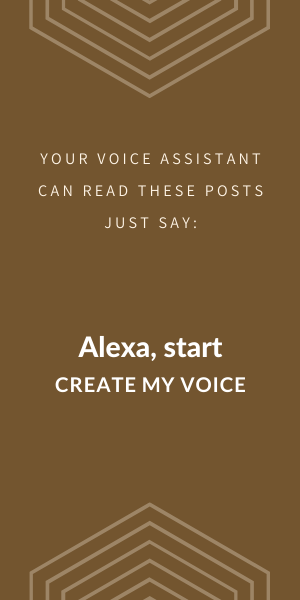To have Amazon Alexa read this blog post to you, just say "Alexa, Ask Create My Voice to Read Blog Post 19".
To have Google Assistant read this blog post to you, just say "Hey Google, Ask Create My Voice to Read Blog Post 19".
]
As I mentioned in a previous blog post titled "New Voices for Smart Speakers", the voices used in smart speaker dialog are getting better. The good news is there are now more voice options available for both Amazon Alexa as well as Google Assistant. While the additional voices open up many possibilities to engage your audience, the ability to use alternative voices does not address the problem of branding.
Listen to this post :
What is a Brand in a Voice First World?
 Some of the elements used to communicate your brand include your logo, tagline, color palette, font, and image style. These are all critical for your website. Consistent use of these branding elements helps your clients understand you and your business, provide a way to differentiate you from similar businesses, and can be used to create stronger bonds with your audience, as well as make your business more attractive. But logos, fonts, and images are not branding elements in a Voice First World. As your audience increasingly use smart speakers for tasks that they previously would use a computer or smartphone, traditional brand elements become invisible. In a voice first environment, when your audience just asks for what they want, they expect the answer to be returned verbally. In a voice first world, what does your brand look like, (I mean, sound like)?
Some of the elements used to communicate your brand include your logo, tagline, color palette, font, and image style. These are all critical for your website. Consistent use of these branding elements helps your clients understand you and your business, provide a way to differentiate you from similar businesses, and can be used to create stronger bonds with your audience, as well as make your business more attractive. But logos, fonts, and images are not branding elements in a Voice First World. As your audience increasingly use smart speakers for tasks that they previously would use a computer or smartphone, traditional brand elements become invisible. In a voice first environment, when your audience just asks for what they want, they expect the answer to be returned verbally. In a voice first world, what does your brand look like, (I mean, sound like)?
What are the Components of a Verbal Brand?
While the first thing we think about when discussing branding may be visual, there are a number of verbal components to a brand as well. Brands are represented verbally by Diction, Grammer, Style, and Voice.
- Diction is our choice of words. Diction encompasses both the complexity of our words as well as the breadth or range of our words.
- Grammar, or Syntax is how we structure our choice of words. Our grammar can range from very simple sentence structures to complicated, dense syntax. The combination of Diction and Grammar is referred to as the "age level" of our writing. When we think of branding, the complexity of our diction and grammar should accommodate our intended audience.
- Style: Because there are multiple grammatically correct ways to communicate a thought, Style or Usage determines how we consistently communicate ideas. Consistent style choices enhance a verbal brand.
- Voice, includes the unique sounds of speech including timbre, volume, language, and accent. If you have two or more people communicating, voice differentiates which person is speaking. With respect to brand, the selection of voice should reinforce the goals of the brand. For example, an institute of higher learning would not engage a child's voice to communicate academic research discoveries.
What is the Importance of a Verbal Brand?
Visual components of a brand are often easier to identify than the auditory components. In fact, sometimes visual design is used to cover for lack of content. But when the audience is not sitting in front of a computer to see the visual components, the quality of the content will be loud-and-clear.
Which brings us back to the importance of ensuring that the content lives up to the image we expect our brand to convey. Ensuring that all verbal components are used together to represent your brand is critical. Starting with the proper choice of words and grammatically correct sentences which conform to an appropriate and consistent style.
What is different between written content and verbal content?
Written content is visual. It is meant to be seen and
What are Options to Enhance a Verbal Brand?
While we can control the content delivered through a smart speaker, we also have some control over how the content is delivered. Both Google and Amazon provide some tools to help customize the delivery of content. Tools like the ability to,
like this number said as a cardinal:
or the same number said as digits:
In addition, on Amazon Alexa Smart Speakers we can dynamically change the voice of the speaker.
Currently, Amazon has voices for 4 English dialects (including American, Australian, British, and Indian) and 5 additional languages including French, German, Italian, Japanese, and Spanish. There are a total of 27 different voices available.
Google has multiple male and female voices for 4 English dialects (including American, Australian, British, and Indian).
As you can see (or hear), there are many options to customize the delivery of content. These (and others) provide a whole new way to see (I mean hear) your brand.
Finally, let's discuss the future of content.
The Coming Power of Verbal Content
The former means of distributing content (like websites, podcasts, blogs, etc.) use monolog. As of this writing, even smart speaker implementations used to distribute content generally use a monolog format. However, the promise of smart speakers is that these monologs will change, to conversations.

